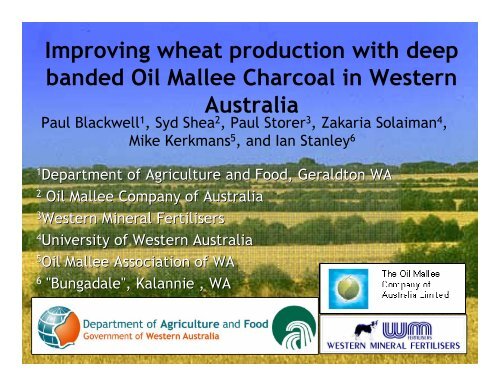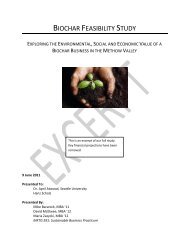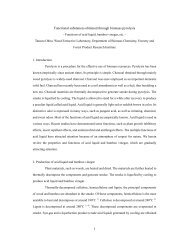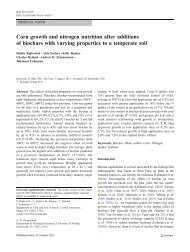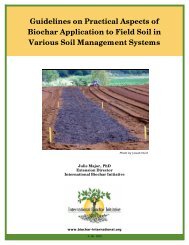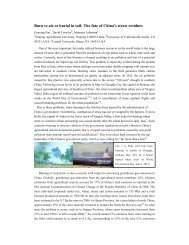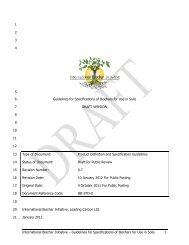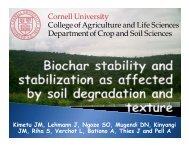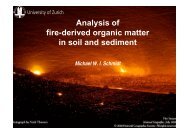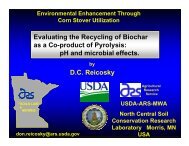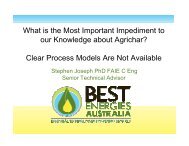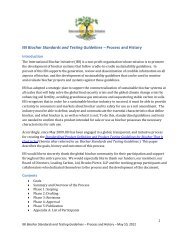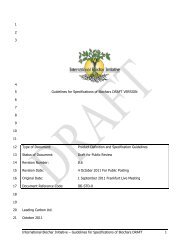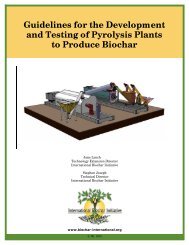Improving wheat production with deep banded Oil Mallee Charcoal ...
Improving wheat production with deep banded Oil Mallee Charcoal ...
Improving wheat production with deep banded Oil Mallee Charcoal ...
You also want an ePaper? Increase the reach of your titles
YUMPU automatically turns print PDFs into web optimized ePapers that Google loves.
<strong>Improving</strong> <strong>wheat</strong> <strong>production</strong> <strong>with</strong> <strong>deep</strong><br />
<strong>banded</strong> <strong>Oil</strong> <strong>Mallee</strong> <strong>Charcoal</strong> in Western<br />
Australia<br />
Paul Blackwell 1 , Syd Shea 2 , Paul Storer 3 , Zakaria Solaiman 4 ,<br />
Mike Kerkmans 5 , and Ian Stanley 6<br />
1 Department of Agriculture and Food, Geraldton WA<br />
2 <strong>Oil</strong> <strong>Mallee</strong> Company of Australia<br />
3 Western Mineral Fertilisers<br />
4 University of Western Australia<br />
5 <strong>Oil</strong> <strong>Mallee</strong> Association of WA<br />
6 "Bungadale", Kalannie , WA
WESTERN AUSTRALIA<br />
location<br />
• Mostly winter rain<br />
from May to October<br />
GERALDTON<br />
Pindar<br />
Kalannie<br />
PERTH<br />
WHEAT BELT<br />
• Many sandy soils<br />
<strong>with</strong> organic matter<br />
50% of Australia’s<br />
<strong>wheat</strong>
20 years<br />
R&D into<br />
charcoal<br />
and soil<br />
fungi in<br />
Japan and<br />
Indonesia<br />
Makoto Ogawa Syd Shea<br />
helped develop<br />
<strong>Oil</strong> <strong>Mallee</strong><br />
concept <strong>with</strong><br />
John Bartle of<br />
CALM<br />
Director of <strong>Oil</strong><br />
<strong>Mallee</strong> company<br />
ALLEY planting<br />
MALLEE in WA<br />
potential<br />
~10 Mt/yr biomass<br />
BLOCK planting
from Ogawa, M. 1994.Symbiosis of<br />
People and Nature in the Tropics.<br />
Farming Japan Vol.. 28 – 5, p10 21.<br />
CHARCOAL improves the MICRO-HABIAT of beneficial soil microbes
Some new fertiliser<br />
suppliers are using<br />
beneficial soil microbes<br />
and mineral fertilisers.<br />
Is charcoal a better<br />
source of<br />
microporosity than<br />
zeolite?
Research questions<br />
• Will charcoal improve crop yields from<br />
poor soil in a dry Mediterranean<br />
environment?<br />
– (50% increase in Sumatra; Yamato et al.,<br />
220% increase in Brazil; Lehmann & Rondon)<br />
• How much soluble fertiliser<br />
• Will mineral fertiliser and inoculated soil<br />
microbes enable more yield <strong>with</strong> charcoal?
Soil biological nutrition model <strong>with</strong><br />
charcoal<br />
charcoal<br />
particle<br />
plant<br />
root<br />
Symbiotic<br />
fungi (AM)<br />
mineral<br />
particle
THE OIL MALLEE INDUSTRY<br />
processing <strong>Mallee</strong><br />
for eucalyptus oil<br />
OIL DISTILLATION<br />
HARVESTING
Pyrolysis <strong>with</strong> an open pan ‘Moki’ method<br />
at Kalannie by Shea, Stanley and Okimori<br />
March 2005; air temp. = 40 o C+!<br />
Yasuyuki Okimori
wood charcoal (Jarrah)<br />
mallee charcoal (‘05 trials)<br />
<strong>Mallee</strong> biomass after oil<br />
extraction
<strong>Oil</strong> <strong>Mallee</strong> charcoal properties<br />
CEC meq/100g<br />
volatiles%dry<br />
ash%dry<br />
fixed C%wet<br />
fixed C%dry<br />
s.area m2/g<br />
0 20 40 60 80 100<br />
%<br />
pH(CaCl 2<br />
) 8.4 EC 25 uS/m N 1.2% P 0.12% K 0.7% Ca 2.8% Zn 38 ppm
<strong>deep</strong> banding charcoal at<br />
Pindar April 2005; Ausplow<br />
Deep Blade System.<br />
thanks to John Ryan
DEEP BANDED MALLEE CHARCOAL<br />
1 t/ha at broad-acre rate<br />
for row spacing of 600 mm<br />
visible effect at<br />
6 t/ha rate<br />
6 t/ha in 100 mm wide band
TRIAL SITES<br />
PINDAR; sandy clay loam<br />
40ppm av. P<br />
KALANNIE; yellow sand<br />
44ppm av. P
Pindar Kalannie 2 Kalannie 1<br />
2500<br />
2000<br />
55 kg/ha soluble fertiliser - May sown<br />
grain yield, kg/ha<br />
1500<br />
1000<br />
110 kg/ha soluble fertiliser - June sown<br />
500<br />
0<br />
0 1 2 3 4 5 6 7<br />
rate of <strong>deep</strong> <strong>banded</strong> charcoal, t/ha<br />
poor yield increase <strong>with</strong> recommended rates of soluble fertiliser
half rate<br />
full rate<br />
2500<br />
2000<br />
+340 kg/ha<br />
grain yield, kg/ha<br />
1500<br />
1000<br />
Pindar<br />
500<br />
0<br />
0 1 2 3 4 5 6 7<br />
rate of <strong>deep</strong> <strong>banded</strong> charcoal, t/ha<br />
18% yield increase <strong>with</strong> half rates of soluble fertiliser at 6 t/ha char
mineral plus microbes<br />
2500<br />
grain yield, kg/ha<br />
2000<br />
1500<br />
1000<br />
+640 kg/ha<br />
500<br />
0<br />
0 1 2 3 4 5 6 7<br />
rate of <strong>deep</strong> <strong>banded</strong> charcoal, t/ha<br />
46% yield increase <strong>with</strong> at least 1.5 t/ha char added to the mineral fertiliser
values of yield increases<br />
Trial site#<br />
and fertiliser<br />
yield<br />
benefit<br />
<strong>banded</strong><br />
charcoal<br />
broad acre<br />
equivalent<br />
kg/ha<br />
charcoal<br />
value ($/ha) for<br />
<strong>wheat</strong> at<br />
carbon<br />
value<br />
kg/ha<br />
carbon $150/t $250/t $/kg C #<br />
kg/ha t/ha<br />
1. 100 kg/ha<br />
mineral+ 1 640 1.5 250 56 96 160 2.84<br />
1. 30 kg/ha<br />
soluble 2 344 6.0 1000 225 52 86 0.38<br />
2. 110 kg/ha<br />
soluble 3 76 6.0 1000 225 11 19 0.08<br />
3. 110 kg/ha<br />
soluble* 83 3.0 620* 140 12 21 0.15<br />
#<br />
<strong>wheat</strong> at $250/t<br />
~$3/kg = $3000/t of carbon!
Mineral+ half rate of soluble full rate of soluble<br />
2.6<br />
2.4<br />
2.2<br />
Pindar<br />
grain yield, t/ha<br />
2.0<br />
1.8<br />
1.6<br />
1.4<br />
1.2<br />
1.0<br />
10 15 20 25 30 35 40<br />
grains per head<br />
grains/ head explained 42% of yield variation = drought stress effect<br />
(the crop needed an ‘irrigation’ to survive 2005)
55 kg/ha Sol. 30 kg/ha Sol. Min+<br />
50<br />
root colonisation; flowering, %<br />
45<br />
40<br />
35<br />
30<br />
25<br />
20<br />
15<br />
10<br />
Pindar<br />
at flowering<br />
5<br />
0<br />
0 1 2 3 4 5 6 7<br />
<strong>deep</strong> <strong>banded</strong> charcoal, t/ha<br />
char increased AMF colonisation (especially the inoculated microbes)
HS LS M+<br />
35<br />
30<br />
0<br />
6<br />
3<br />
6<br />
Grains per head<br />
25<br />
20<br />
0<br />
3<br />
6<br />
0<br />
3<br />
Pindar<br />
at flowering<br />
15<br />
10<br />
0 5 10 15 20 25 30 35 40 45 50<br />
root colonisation September %<br />
AMF colonisation associated <strong>with</strong> grains/head<br />
- may have helped reduce drought stress – fungal hyphae extend root system
S55 S30 M+ S110<br />
30<br />
biomass at tillering, g/m 2<br />
25<br />
20<br />
15<br />
10<br />
SYMBIOTIC ?<br />
PARASITIC ?<br />
5<br />
0<br />
0 1 2 3 4 5 6 7<br />
<strong>banded</strong> charcoal, t/ha<br />
char increased early growth for lower soluble P conditions<br />
But decreased early growth for higher soluble P conditions
Interpretations<br />
• Valuable yield increases from char addiction<br />
– broadacre agriculture, low native AMF<br />
• Very efficient Carbon sequestration <strong>with</strong> low<br />
rates of low C char<br />
– Few soil effects, long term benefits?<br />
• Char seems to have increased drought<br />
tolerance by encouraging symbiotic fungi.<br />
• Higher levels of soluble P may suppress<br />
symbiosis – more value in low fertility situations.
Questions<br />
• Can these results be repeated?<br />
– pot trials UWA, small plot trials. NLP submission<br />
• How low is the char requirement of the mineral<br />
fertiliser?<br />
– 2007 small plot trials<br />
• How long can the char effect last?<br />
– resowing Pindar and Kalannie trials<br />
– NLP submission<br />
– ARWA support a research potential seminar in June<br />
– KEY information for potential Char economics
INTEGRATED WOOD PROCESSING (IWP) plant at NARROGIN<br />
5MW plant = $6.2M over 20 years; est. Bell and Bennett (2002)
Ogawa and Okimori (2004)
Ogawa and Okimori (2004)
A BENEFICIAL SYSTEM?<br />
THANKYOU<br />
Sylvain Pottier<br />
Yasuyuki Okimori and Makoto Ogawa of<br />
Kansai Environmental Engineering Centre,<br />
Kansai Electric Co. Ltd and General<br />
Environmental Technos Co., Ltd. and the<br />
<strong>Oil</strong> <strong>Mallee</strong> Company for financial support<br />
Ausplow Ltd for the use of their plot<br />
airseeder. Andrew Donken<br />
Victor Dodd and Doug Cail<br />
Dave Gartner, Ben Parkin and Chris Gazey<br />
United Farmers Cooperative and Hans<br />
Schoof for soil testing and interpretation.<br />
Stephen Davies, Bill Bowden, John Bartle,<br />
and Tony Vyn for field advice and<br />
assistance.


